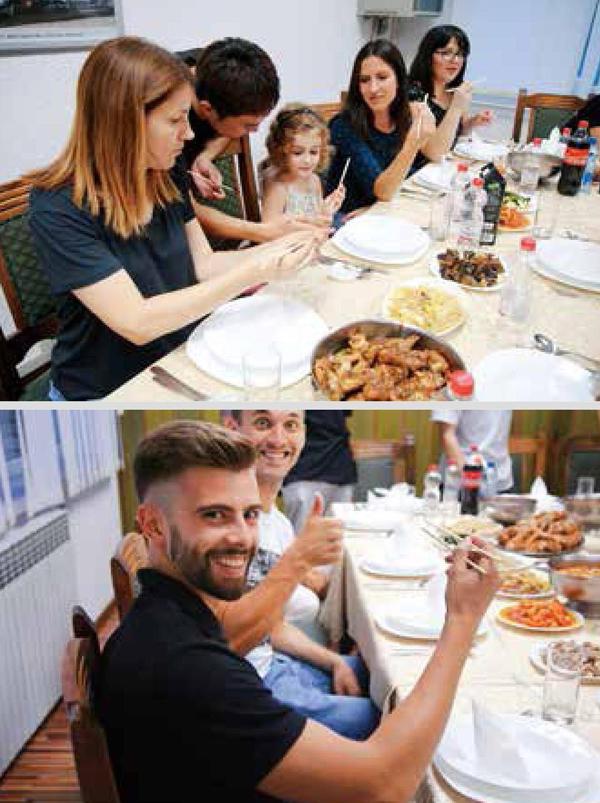浙大学子化身文化使者
2018-10-11李济沅王湛
李济沅 王湛
浙江大学电气工程学院“致远”计划的同学们,今年夏天组成了“讲好中国故事,传播中国声音”暑期社会实践团,奔赴“一带一路”重要节点国家塞尔维亚,开展了为期一个月的实践活动。
在贝尔格莱德街头的采访
八月的塞尔维亚晴朗而干燥,湛蓝的天空没有一丝浮云,一大早,夺目的阳光就把贝城里外照了个通透。位于多瑙河南岸、萨瓦河东岸的贝城老区面积不大,特斯拉博物馆、旧街、共和国广场等历史地标分布集中。社会实践团成员们选择距离最近的圣萨瓦教堂作为街头采访的第一站,开始“暴走”贝尔格莱德。
当你听到“中国”,你脑子里最先出现的是哪个词?
龙,汉字,大熊猫,工业,高铁……
塞尔维亚国土面积略小于浙江省,其居民出行主要依赖公路交通。从位于中部的首都贝尔格莱德,到位于最北部的第五大城市苏博蒂察,全程约190公里。但汽车一般会在中北部的第二大城市诺维萨德经停,鲜有往返于两地间的直达班次,总耗时超过3小时。如果选择乘火车,耗时几乎为汽车的两倍。反观国内,杭州到上海距离约180公里,往返于两地的高铁耗时不过一小时。塞尔维亚人对中国高铁的速度,在惊讶之余也有几分羡慕之情。
你的手机是什么牌子?
三星,华为,苹果,一加,小米,联想……
中國产手机已然成为国际市场的新贵。贝城大街不乏宣传中国手机的广告喷绘。手机作为通信设备,在当地拥有极其广泛的持有率。受访者中,有相当一部分人正在使用中国品牌的手机,华为、小米、联想、一加都有不错的市场表现。而关于其使用体验,不少受访者对其功能和质量赞不绝口,甚至主动掏出手机向采访的同学展示。
你吃过中餐么?
年轻人多回答“喜欢”“想尝试”。
“功夫餐厅”老板杨芳霞女士向实践团讲述了她在塞尔维亚创业14年的故事。2008年金融危机之前,她在塞尔维亚从事服装贸易行业,之后转行做中餐业,至今正好10年。据她讲,她的中餐生意经历了两次重要的转折点:一是2013年“一带一路”倡议的提出,此后越来越多的中国企业开始在塞尔维亚寻找商机,她的中餐生意也从中获得了更多机会;二是2017年的中塞免签政策的落地,贝城街头越来越多的中国游客成为她的重要客源。现在,塞尔维亚较大的城市都分布有中国餐厅(以快餐居多),虽然菜品的口味会根据当地人的喜好或多或少作出些调整,但“宫保鸡丁”“辣子鸡”等中国特色菜仍受到当地食客的青睐。
你(中国游客)为什么选择来塞旅游?
免签方便,风情吸引。
社会实践团在共和国广场偶遇了不少中国游客。一对来自深圳的小情侣直奔塞尔维亚来了一场说走就走的蜜月旅行。在贝尔格莱德的两天行程中,当地人民的热情款待令他们倍感温馨。
浙大学子带来中国声音
你听说过中国新“四大发明”吗?你知道“一带一路”与世界青年有什么关系吗?社会实践团同学来到了诺维萨德大学孔子学院开展文化宣讲,不少塞尔维亚当地的青年专程赶来。
诺维萨德是塞尔维亚第二大城市。诺维萨德大学坐落于主城东岸的多瑙河之滨。诺维萨德大学的孔子学院成立于2014年,下设诸多汉语教学点,分布于塞尔维亚各个城市,4年间已经吸引了大批中华文化爱好者前来交流学习,办学规模与影响力正在逐年扩大。
孔子学院的门厅是一间中式书房,厅内摆放着一把扶手椅,一方长书案,靠后的两侧墙角则分别对称放置有大小四只置物架,家具均以土漆漆制,与三面红墙相得益彰。两面侧墙分别挂着孔夫子的画像和学生活动的相片,书案背墙中央则为毛笔题写的书院全名。门厅旁边的小门通往学院的画室,有学生着汉服在其中研习功课,国画、茶道、快板,其技艺之纯熟、作品之精妙令人赞叹。
在场的塞尔维亚学生超过80%都在使用中国品牌的手机,没有使用的打趣说“自己像个另类”。在宣讲会上,社会实践团成员周一同学特意提前剪辑了一个视频短片作为引子,与大家互动探讨塞尔维亚青年眼中的中国。从他们口中,社会实践团成员们听到了更多关于中国的关键词,例如汉语桥、支付宝、微信、共享单车……得益于日益增进的双边交流,塞尔维亚这片千里之外的异域土地正在逐渐了解中国。
在活跃的气氛中,实践团成员何哲楠同学以“路”为关键词,从自己老家的乡村小路讲起,让大家感受到中国的快速发展之路和联通世界之路。“正是得益于‘一带一路,让我能有机会来到这个魅力十足的国度,期待有一天中国的高铁、共享单车、移动支付也能来到塞尔维亚,而塞尔维亚的特色牛奶也能出现在中国餐桌上……”
一个个生动的中国高速发展的例子,流利的英文和精彩的展示,让在座的听众对这群浙大学生竖起了大拇指。
“中国味道”香飘塞尔维亚
位于苏博蒂察的卧龙控股集团ATB SERVER子公司是社会实践团成员的实习地,三周的实习经历充实而富有挑战性,社会实践团成员们也受到了企业的热情款待。为了表达感谢,同时也让当地人品尝中国美食、体验中国文化,成员们决定烹饪一席丰盛的中餐晚宴作为回馈。
烹饪所用调料均是在贝尔格莱德的中国市场购买的。塞尔维亚的厨房并不使用明火,多用烤箱。“厨师们”用尽十八般武艺,完成煎、炸、炖、炒等各道工序,历经三个半小时,将十余种家常菜送上饭桌。从蛋炒饭,到玉米排骨汤、可乐鸡翅、蘑菇肉片、酸辣土豆丝,甚至四川火锅,菜品齐备,可谓是应有尽有。
为了让这顿晚宴更有中国味,成员们对场地进行了精心布置。邬博骋同学用毛笔在餐厅大门题写了对联:“闻香且下马,知味暂停车”,并用小楷题写了“今日菜单”。另两名同学则与提早前来的职员一起,剪窗花,画脸谱,做手工。精巧的蒙古包与别致的“醉翁亭”,拼好了放在桌上,成了极具中国韵味的手工艺品;大红的窗花与色彩斑斓的脸谱,剪好画好了贴在墙上,平添了许多喜气。而餐桌上已经提前放好了竹筷子。
晚宴當地时间晚上七点半准时开始。从品尝菜肴,到体验“中式帮忙夹菜”,到天南地北畅聊,一桌美食似乎超越了文化背景的固有差异,把种族不同、肤色不同、语言不同的中国大学生和塞尔维亚青年紧紧地联结在一起。
中国故事,就是中国人的故事;中国声音,就是中国人的声音。让世界了解中国,也是每一个中国人的事。
(本文图片由郝唯粟摄)
A group of students from School of Electrical Engineering of Zhejiang University spent a month in summer 2018 promoting Chinese culture in Serbia. The group visited Belgrade, Novi Sad, Subotica to know better about this country situated at the crossroads of Central and Southeast Europe.
The students not only did sightseeing around but also interviewed local residents to find out how much they knew about China. In a random street survey near St. Sava Church in the old downtown of Belgrade they got some interesting answers.
The students first question was, “What pops to your mind first when you hear the word China?” The answers included dragon, Chinese characters, panda, industry, and high-speed railway. The students found why high-speed railway figured so much in the mind of Serbians: Serbia is slightly smaller than Zhejiang Province in terms of geographical area. Highways are the main means of transport. It usually takes about three hours to ride a bus to reach Subotica about 190 kilometers away from Belgrade. Usually, the bus will stop at Novi Sad, the second largest city of the country. Buses seldom run directly between Belgrade and Subotica. It takes nearly 6 hours to travel from Belgrade to Subotica. Hangzhou is about 180 kilometers southwest of Shanghai. A high-speed train takes about one hour to cover the distance.
The second question was, “What is the make of your cell phone?” The answers covered well known brands such as Samsung, Huawei, Apple, OnePlus, Xiaomi, and Lenovo. Cell phones made by Chinese manufacturers are now a new trend on the international market. The students saw large-sized advertisements on Chinese cell phones in Belgrade. Most people in Belgrade have cell phones and quite a few people surveyed had Chinese cell phones. Huawei, Xiaomi, Lenovo and OnePlus worked quite well in Serbia. Some interviewees showed their phones to the students from Zhejiang.
The third question was, “Have you ever tried Chinese food?” the young people replied that they liked Chinese food or that they would like to have a try. Yang Fangxia, a restaurateur in Belgrade, had been Serbia for 14 years. Before the economic crisis in 2008, she was engaged in garment business. In 2008, she turned to Chinese food. Her restaurant business experienced two turning points: her business picked up in 2013 when more Chinese businesses came to Serbia for a market share after the Belt and Road Initiative was launched. The second turning point was 2017 when Chinese tourists could visit Serbia without a visa. Chinese tourists brought in by the new policy are now her major customers. Nowadays, big cities in Serbia have Chinese restaurants. Though most dishes on the menus are somewhat modified to cater to local customers, some Chinese dishes such as Kung Pao Chicken and Spicy Chicken remain popular.
The students also put a question to Chinese tourists they met in Belgrade: “Why did you pick Serbia as your tour destination?” The answer was similar: it takes no visa to travel and Serbia offers very alluring sights.
The students from Zhejiang University held a special lecture at Confucius Institute of Novi Sad University. It is the second largest city of the country. The Confucius Institute, founded in 2014, now offers Chinese courses in major cities in Serbia. Over the past four years, these language courses have attracted many local residents. He Zhenan, a student from Zhejiang University, gave a talk centered on “road”. He talked about the small roads in his home village and then talked about Chinas road to fast economic growth and to the outside world. “Thanks to the Belt and Road Initiative, I am able to visit Serbia, a country for charms. I am looking forward to the day when Serbia will have high-speed railways, shared bike services, mobile payment systems and when Chinese people will have milk from Serbia on their kitchen table.”
During their trip to Serbia, the students from Zhejiang University visited ATB Server, a Serbian business in Subotica, which is affiliated with a Chinese multinational corporation. The students received warm welcome at the business. In order to say thank-you to the local host, the students prepared a dinner. All the food ingredients were bought at a Chinese supermarket in Belgrade. The students spent three hours and a half preparing over 10 courses. They also decorated the dining room with Chinese gadgets such as paper-cutting pieces and Peking Opera facial masks, adding a Chinese touch to the dinner.
